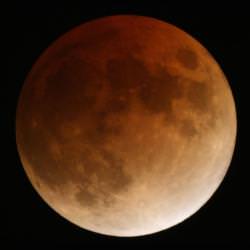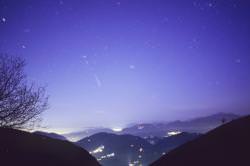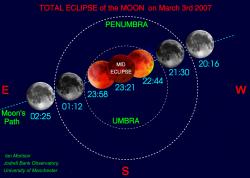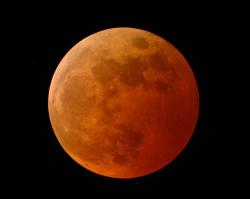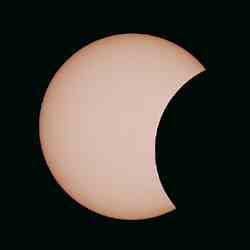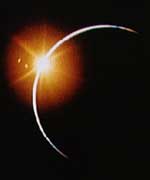
Image credit: NASA
NASA is planning to send people back to the Moon. Target date: 2015 or so. Too bad they won’t be there this Sunday because, on April 24th, there’s going to be a solar eclipse, and you can only see it from the Moon.
On Earth, solar eclipses happen when the Moon covers the Sun. On the Moon, the roles are reversed. It’s Earth that covers the Sun. Such an eclipse is “a marvelous sight,” according to Apollo 12 astronaut Alan Bean, who saw one in 1969. He was flying home from the Moon along with crewmates Pete Conrad and Dick Gordon when their spaceship flew through Earth’s shadow. “Our home planet [eclipsed] our own star.”
No one will see the April 24th eclipse, but we can imagine what it would be like:
You’re standing on the Moon. It’s broad daylight, almost high noon. The Sun is creeping slowly across the sky. How slowly? A lunar day is about 29.5 Earth-days long. So the Sun moves 29.5 times slower than our Earth-sense tells us it should. At that leisurely pace, the Sun approaches a dark but faintly-glowing disk three times its own size.
The disk is Earth with its nightside facing the Moon. You can see moonlit clouds floating over Earth’s dark oceans and continents. You can also see a faintly glowing ring of light around the planet–that’s Earth’s atmosphere with sunlight trickling through it. A telescope would show you Earth’s city lights, too. Beautiful.
Then the eclipse begins.
Looking through dark-filtered glasses, you watch the Sun slip behind Earth. Earth’s atmosphere, lit from behind, glows red, then redder, a ring of fire the color of sunset, interrupted here and there by the tops of the highest clouds.
Ninety minutes later–patience is required!–only a little bit of the Sun remains poking out over the edge of the planet. Arranged just so, the pair remind you of a giant sparkling diamond ring.
The Sun never completely vanishes because this eclipse is partial, not total. During a total eclipse, Earth would hide the Sun completely, which has the odd effect of turning the Moon blood red. But that’s another story.
Partial eclipses, while not as eerie or dramatic as total eclipses, are still good. In fact, future space tourists will probably rocket to the Moon to see them. It’ll be an exclusive club, people who’ve witnessed Earth taking a bite out of the Sun. The membership in 2005 is only two: Alan Bean and Dick Gordon, the surviving crew of Apollo 12.
Stuck on Earth, what can you do? As a matter of fact, it is possible to observe this Sunday’s solar eclipse from Earth in a roundabout way:
During the eclipse, Earth’s shadow will fall across the Moon and we can see that happen. Our planet’s shadow has two parts, a dark inner core called the umbra and a pale outer fringe called the penumbra. (Aside: Step outside on a sunny day and look at your own shadow. It’s dark in the middle and pale-fuzzy around the edges. You have your own umbra and penumbra.) The Moon on April 24th will glide through Earth’s penumbra, producing what astronomers call a “penumbral lunar eclipse.”
Penumbral eclipses are not easy to see because the penumbra is so pale. If you’re enthusiastic about such things, however, it’s worth a look. A subtle but distinct shading should be visible across northern parts of the Moon during greatest eclipse around 09:55 UT on Sunday morning, April 24th. That’s 02:55 a.m. PDT or 05:55 a.m. EDT in North America. The best place to be is the Hawaiian Islands where the eclipse happens only 5 minutes before local midnight on Saturday, April 23rd. The Moon will be high in the sky, ideally placed.
Even in Hawaii the experience is subtle. Not impressed? You’re just on the wrong world.
Original Source: Science@NASA

